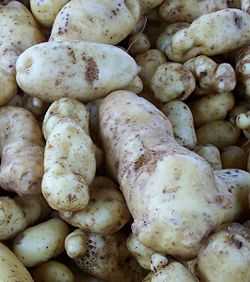Potato
The potato (pl. potatoes), also called Irish potato or white potato, is one of the world's most important foods. It ranks as the fourth-most-important food crop, after corn (maize), wheat and rice. It provides more calories, more quickly, using less land and in a wider range of climates than any other plant.
It is the root of an herbaceous plant (Solanum tuberosum) that originally evolved in the northern Andean highlands.
The potato was cultivated by various Andean civilizations for at least 2000 years before the Spanish were introduced to it by the Incas in the 16th century. During that time, many different varieties were developed by the Andean peoples, but it was mainly the common white potato that was brought to Europe for cultivation. The potato became a staple crop across northern Europe, but nowhere so much as in Ireland, where an epidemic of potato blight in 1845-46 produced a famine that killed a million or more people and forced as many to emigrate.
The United Nations has declared 2008 the International Year of the Potato.[1] It hopes that greater awareness of the merits of potatoes will contribute to the achievement of its Millennium Development Goals, by helping to alleviate poverty, improve food security and promote economic development.
The great diversity of potatoes developed in the Andes has been expanded even further around the world, so that there are varieties suited to nearly every climate, with harvest times anywhere from midsummer to late fall. Most prefer a well-drained, slightly acid soil, and are planted in the early spring.
Potatoes also come in a wide range of colors, with skin anwhere from brown to purple to red and white, yellow, red, or blue flesh. They are eaten fried, baked, mashed, boiled, or made into flour, and different varieties have been developed for each of these specific purposes.
Agriculture
Many countries produce potatoes, primarily for home consumptions. The international market is small. In the U.S., production is concentrated in Idaho and Maine.
Peru
Potatoes were first domesticated in Peru more than 7,000 years ago. The country is home to up to 3,500 different varieties of edible tubers, according to the International Potato Center, whose headquarters are near Lima. The United Nations has designated 2008 as the "International Year of the Potato" and not surprisingly Peru hopes to use this to draw attention to itself and its crop. Alan García, the president, has ordered that a government-sponsored program of free breakfasts for poor families should serve bread made from a mixture of potato flour with wheat, which is more expensive and has to be imported. He also wants government food services to start serving chuño, a naturally freeze-dried potato that is traditionally eaten by Andean Indians. Boiled chuño and cheese are said to have replaced sandwiches at cabinet meetings. Peru grows 25 varieties commercially, but exports little. Peruvian yellow potatoes are prized by gourmets for mashing; tubular ollucos are firm and waxy.
Production and consumption
The twn leaders in production in 2007, in million tonnes:
- 72 China
- 36 Russia
- 26 India
- 19 Ukraine
- 18 USA
- 12 Germany
- 11 Poland
- 8.5 Belarus
- 7.2 Netherlands
- 6.3 France
Belarusians lead the world with 360 kilos per consumed per person per year.
History
Bibliography
- Economist. "Llamas and mash," The Economist Feb 28th 2008 online
